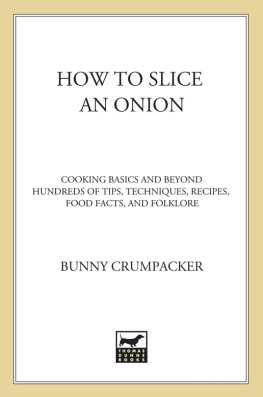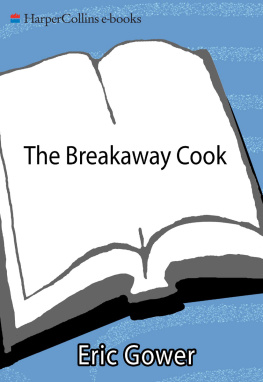Contents
Landmarks
Print Page List
ACKNOWLEDGMENTS
It takes a village to write a book. Or make a baby. Or raze a barn. Its more than just writing words until youve fulfilled your contractual obligations. Its about a community, and thats why I want to acknowledge you.
You may have sent me recipe ideas and cooking tips or helplessly watched as I stole one from you. Perhaps you edited my book proposal, my first draft, or translated English into Italian while being stone-cold Italian. Perhaps you gave me a cabin to write in where I was scared of being murdered or a house to stay in while I accidentally underfed your dog. Or maybe you invited me to your mountain matador library.
You may have made me a cutting board, sent me an engraved wangjangler, gave me feedback, offered ideas, advice, and encouragement, leant me your dog, leant me your kitchen, asked me to cook yams, collaborated with me in your garage, built me a furnace space ship, shot me with a laser beam, or said, This needs some acid, while blending herb dressing in a cabin that time in July.
You might have reminded me to eat or made me a meal while I appeared to be writing but was actually wasting time online. Or maybe you gamified texting to help me focus through distraction. Or perhaps you made me food since birth or rightfully told me to tone down my salty language, in addition to countless helpful and supportive things throughout the years. Or maybe youre on my ghostwriting team and thats why this book is haunted.
To all of youfamily, friends, loved ones, ghoststhank you so much.
At Clarkson Potter Id like to thank Amanda Englander for championing this project, along with Gabrielle Van Tassel, Stephanie Huntwork, Francesca Truman, Mark McCauslin, Kelli Tokos, Erica Gelbard, Daniel Wikey, and Eleanor Thacher for all of your work, patience, editing, designing, ideas, and everything that goes into making a book.
Thanks the photography team of Andy Lee, Thom Driver, Angie Mosier, and Dave Crawford for the great photos, propping, styling, rides, and laughs. Thanks to Allison Renzulli for taste-testing skills.
Thanks to Anthony Mattero for the adept agenting, along with Alex Rice. And Randi Siegel for the impossibly thorough and dedicated managerial prowess.
And to everyone whos been watching, I appreciate it enormously and constantly. And to those of you who are reading this book, I am especially proud of you. For reading. For some reason thats supposed to be a good thing to do.
Id also like to thank the lumberjacks. Without their constant jacking of lumber, we wouldnt have books. And what kind of world would we live in without books? A sad, sad world with a lot more trees.
And finally Id like to thank the early humans, now long passed, who first discovered food and decided to try eating it. Without them, this book would never have been possible.
SOME BASICS
Volumes could be written about the basics of cooking. Bibles even. Maybe even an entire book or possibly a whole chapter, such as this one. This chapter isnt meant to be comprehensive, just comprehensible. I will not attempt to cover all of the basics, but I will mention a few things that will set you up to cook most of the stuff in this book.
In addition, this information will also set you up to make three to four hundred thousand recipes not in this book. Those recipes can be found in other books, on the Internet, from friends and relatives, from enemies and strangers, scrawled on old withering parchment in thrift stores, dreamed up inside your own mind, or whispered in your ear by dead people. Recipes that come from any other source are not to be trusted and should be immediately discarded.
If youre brand new to cooking, this is the part of the book where I overwhelm you with information to the point of frustration and you dont bother trying. If you are prone to that kind of response, the best way to approach this section is to skip it entirely and go straight to the recipes and try them out. If you insist on reading this chapter, just know that there isnt anything in here thats crucial, except for all of the stuff that is essential, not to mention the few bits that are vital. What Im saying is, dont feel like you have to go out and buy all of the stuff mentioned in this chapter before you start. There are workarounds for almost anything and I believe in you. Or I am at least willing to say that I believe in you even though I know nothing about you.
THINGS YOU MIGHT NEED
TASTE BUDS
Everything that has ever been cooked has been made to taste. Someones taste. In other words, a recipe is just, like, someones opinion, man. Try out the recipes as written and adjust parts of them at your leisure. If leisure isnt your thing, adjust things according to your uptight intensity.
Dont like an ingredient? Swap something else in, or dont swap anything in at all. Maybe it will still be good, maybe not. Theres one way to find out. And that way is to convince a friend to make it for you, and then try it and see what you think.
The way you can tell if something you made is good is by tasting it. If you like how it tastes, then it is good. If you dont like how it tastes, then it is not good. At least not right now, although it might be good one day, or it might be good right now for someone else. I used to hate onions, but now I cant live without them. Thats not an exaggeration. I am hooked up to an onion juice IV in order to keep me alive, because without onions in my blood I have no will to live. High-end chefs might make scrambled eggs that have the texture of hot custard. But if I want to eat something with the texture of hot custard, Ill eat hot custard. And maybe that hot custard will be made of eggs cooked by a high-end chef. Maybe not. The point is, trust your taste, but be open to it evolving. Or dont.
A HEAT SOURCE
Cooking, by definition, involves one or both of two things: combining ingredients and heating them. There are many heat sources to choose from, each more dangerous than the next. Excessive heat can cause pain to any part of the body that contains skin, bones, or living cells. Make sure you choose the heat source that is just dangerous enough for you. Consider the following choices.
FIRE
Using this yellowish, orangish, pointyish, shapeshifting, gas-like substance to cook is a tradition that goes back dozens of years. You really have to keep your wits about you when working with this unpredictable stuff, as many variables affect how it behavesparticularly how angry youre feeling. Also, fire is contagious, so be careful when you get close to it. Luckily, fire usually burns upward as heat normally rises, so you can mostly count on that. I recommend using fire contained in a hard metal box, such as a barbecue. If a barbecue is not available, try cooking over a wild prairie fire.
THE SUN
Cooking with the sun is the trickiest approach, on account of the surface of the sun being almost 10,000F. This method requires you to expose the food to the sun for no longer than a few millionths of a second, either with quick hand movements or with an astronomically fast rotating rotisserie (best operated by the gusting winds of a Category 5 hurricane). If you cook with the center of the sun, the temperature is closer to 27,000F, which requires a slightly shorter cooking time, and a very good pair of gloves. Forearm guards are also recommended.














